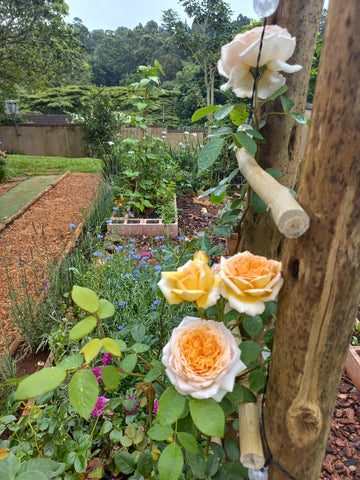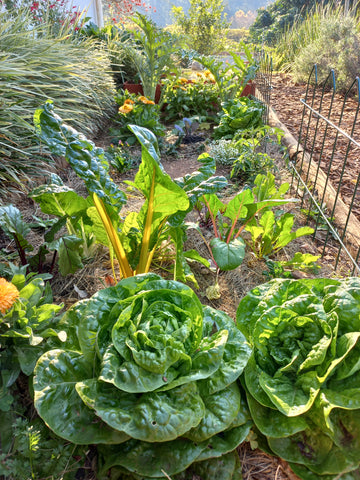Tree of life!
When my house was built nearly 20 years ago, there was a young Pigeonwood tree on the property. As the years went by the tree slowly grew in stature. Though there are other large trees we cherish in the garden, this one was most loved. My late grandmother gave us a few strands of ivy from her beautiful garden and this found a happy home twirling up the trunk of the Pigeonwood until it hung in swathes from the highest branches. My grandmother's garden is lost to us now, as is she. But her ivy still grows in thick ropes of green around the tree trunk.

Only the trunk though - because now the Pigeonwood is also lost to us.

In the spring of 2021, we had to make the difficult decision to have the tree felled before it caused damage to the house and property wall. It had begun to age and become brittle and had thus become a danger. It was a sad day when the tree fellers arrived to take down this friendly giant. It had been home to countless birds who'd nested in the stout branches. It had provided the monkeys with safe passage across properties. It had given us shade and, hung with garlands of ivy which would sway in the breeze against the blue winter sky, it had also given the whole garden a focal point. But, sad as we were to lose her, we have learnt that all things have their seasons and, in her wake, the garden has transformed. This is how it happened.
The day the tree was felled, we stood among the fallen branches. It had been a very hot day filled with the sound of chainsaws and cracking wood. But now all was still. Sawdust lay in thick piles around the base of the trunk which we deliberately had cut off high, to give the sentimental ivy a place to grow. The sky seemed bigger now that it wasn't filled with the canopy that had characterised the view for so long. The light of the late afternoon fell in yellow stripes across the struggling grass which had never thrived in the shade of the canopy. The garden was bathed in sunshine for the first time in over a decade. And despite our sadness, a bud of excitement began to open in our hearts. What if we planted a real garden here? What if we could grow food and flowers in the hours of sunshine now free to lie across the space usually shrouded in shade? What if the death of this tree could bring forth life? Would that not be a fitting legacy?
And so, we began. With very few bought materials we levelled the ground, amended the soil, and laid out a small, simple potager garden with concrete blocks.

The weeks passed. Cardboard was laid over weedy walkways and topped with bark chips.

Seeds were sown in the rich compost which now filled the beds.

We built an arch and strung it with fairy lights.

We began to harvest radishes and potatoes, even as we were still planting lavender to border the pathways. Early mornings in summer were a riot of blue cornflowers and apricot climbing roses.

Green beans snaked their way up the bamboo tripod we foraged from an obliging hedge and cable tied together to provide a vertical growing space. Wild cherry tomatoes, unplanned but most welcome, seeded themselves amongst the beans.

In autumn purple echinacea, long desired, slowly settled in amongst the purple aubergines.

Shy violets began to flower along the stone border. Chamomile and violas; calendula and red cabbages; rainbow chard and my first ever parsnips.


The winter that is almost passed has brought forth poppy seedlings and new strawberries.

And, as I sit in the garden in the late afternoon light of July, I remember that it's been almost a full year since the Pigeonwood's heavy green branches were spread over the garden. I still miss her. But in her wake there has been season after season of life in the garden. What started as an idea has become this beautiful reality. It wasn't immediate. It wasn't easy. We've had setbacks and disappointments along the way. We've made some mistakes. But even so, everyday the lavender flowers are weighed down with bees, both honey and solitary kinds. Bumblebees bump into the indigineous irises which grow thickly around the remaining trunk. Butterflies weave above the comfrey and borage. Peas have replaced the beans and are currently flowering quietly on the bamboo trellis. A second generation of tomatoes and chamomile have suddenly sprouted.

There is dirt under my nails and the Seeds for Africa catalogue is bookmarked on my laptop. Plans for extending the growing space are now underway. Not only has this small potager garden given us food and added beauty to the space we steward, it has also provided the opportunity to put my hand to something and to feel the benefits of that in my heart and mind. There is something life-giving about having a hand in the flourishing of growing things. And so, a year on, I often raise my gaze to the ivy clad Pigeonwood trunk and think of the roots that still give strength and structure to the ground beneath it, and to the blaze of life that now grows in her shadow.
About the Author
A homesteader at heart, Michelle Edgcumbe lives in a country neighbourhood in Kwazulu-Natal. By day she commutes into the city to work but afternoons and weekends are spent tending her small garden. With able assistance from her enthusiastic golden retriever, she is currently digging up another section of lawn to extend the potager space. She dreams of one day owning several egg laying hens all named after Jane Austen characters, but for now is satisfied with trying to grow more of her own food and aiming to live more simply and sustainably. She blogs about these things at nutmegandtime.co.za




